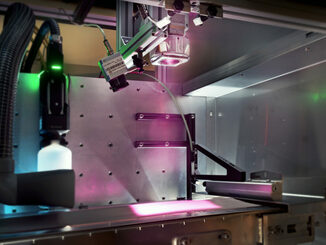
At SPIE Photonics West in San Francisco, California, the high-power diode laser specialist Laserline, Inc. Laser solutions for key industrial applications such as the production of electrical copper components, semiconductor processing and the drying of lithium-ion batteries. One of the technology leaders in the field of infrared and blue diode lasers, Laserline has a blue CW laser with 4 kW output power and a blue 200 W pulse laser in its portfolio.

© Laserline GmbH
With the LDFblue 4000, the world’s first commercially available blue diode laser with 4 kW CW output power, Laserline is underlining its expertise in industrial lasers in the blue wavelength spectrum. The product range covers a range starting at 400 W and is available in three beam qualities with beam guiding cables of 400 or 600 µm diameter.
Blue diode lasers are much more energy-efficient than conventional high-power lasers in the visible range, which results in significantly lower operating costs. As pure semiconductor lasers, they are practically maintenance-free. The outstanding power range and the possibilities of beam shaping open up a broad spectrum of previously unused applications such as the surface modification of semiconductor materials and the ablation of thin layers.
The main areas of application for the blue high-power lasers are copper welding and copper coating as well as additive manufacturing. Its wavelength of 445 nm is absorbed by copper alloys ten times better than infrared radiation, resulting in almost perfect melt pools without pores and spatter in a thickness range of up to 2 mm. In the additive manufacturing of copper components up to the size of rocket engines, it enables build rates more than five times higher than infrared lasers and a far above-average powder efficiency of up to 90 percent.
In addition to the blue CW systems, a new pulsed blue 200 W prototype diode laser was on display at the stand. It is characterized by pulse durations of less than 1 µs and a line spot of 2 mm x < 100µm for modern front-end semiconductor applications. It demonstrates Laserline’s ability to adapt products to specific application requirements.

© Laserline
Solutions for the latest innovations in the field of semiconductor packaging, such as Laser Assisted Bonding (LAB), were also on display. LAB offers advantages over conventional bonding methods such as reflow ovens. The precise energy supply of diode laser systems, which use our OTZ zoom optics, leads to a lower thermal load and thus to a significant reduction in distortion. This approach is particularly useful for thin substrates and offers excellent stability with different housing types. LAB solutions also offer a significant improvement in production costs, as they require less space and energy compared to reflow oven solutions, while ensuring a high throughput. Direct chip attachment applications with dimensions from 3 x 3 to 100 x 100 mm² and material thicknesses between 50 and 780 micrometers are used in modern mass production.
The Laserline stand was rounded off by the presentation of diode laser-based drying processes for battery foils as a supplement to hot air-based ovens. LIB battery cells are made from double-sided copper and aluminum foils that are wet-coated with the active battery materials. Conventional drying systems require large amounts of very expensive dry production space in modern GigaFabs and consume around 30 percent of the total energy used in cell production.
Research facilities and various pilot lines worldwide have shown that the use of high-power diode lasers increases drying performance and roughly halves the space required for drying. Laserline’s systems typically have an output of 15 to 30 KW, a narrow IR light beam, a precise top-hat beam profile with a width of up to 1.4 m and a leading energy efficiency of over 50 percent. Users benefit from 28 percent lower operating costs (OpEx) and 19 percent lower investment costs compared to conventional ovens.
Web:
www.laserline.com



